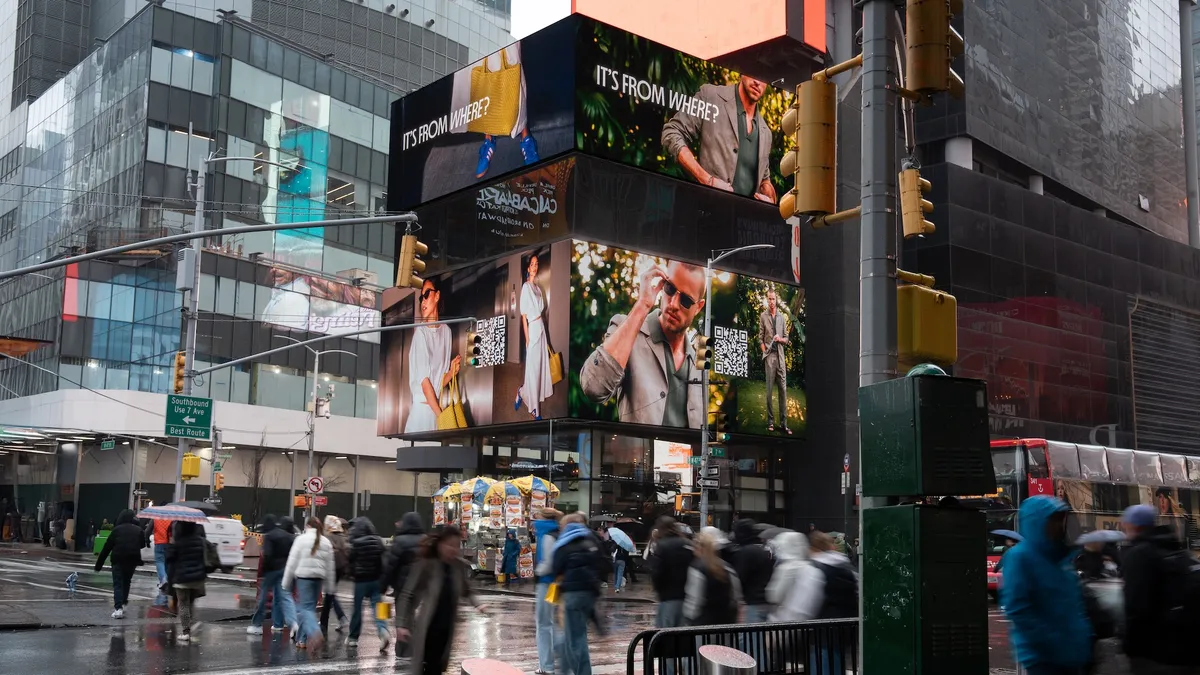As interest and investment in generative artificial intelligence (AI) surges, marketers are rushing to test how the technology can be a part of their advertising campaigns. Some companies, including Mondelēz International, have teamed with agencies and consultancies to boost their efforts around generative AI, while others like Starburst have used the tech to scale major campaigns. Fintech company Klarna claims to have already saved millions on marketing with AI.
Not all generative AI marketing efforts are created equal, however. Toys R Us received backlash for releasing what it claimed was the first brand film to use OpenAI’s text-to-video tool Sora while Google pulled a divisive ad around the Summer Olympics promoting its AI products. With those challenges in mind, crafting a video ad campaign entirely with generative AI represents a bold, if risky, move. But that is exactly what IT management platform Atera has done, Marketing Dive can exclusively share.
Two news ads illustrate the stuff IT managers’ dreams are made of — working in a tropical locale while critters play musical instruments and a UFO destroying a printer factory, for example — before cutting to their true desires: an AI-powered, all-in-one management platform like the one Atera provides. The rest of the nearly minute-long spots are filled with images of Atera’s solutions in action, alongside more fantastical scenes of white collar-workers parachuting while at their desks, astronauts on laptops and robotic speedboat copilots.
Marketing Dive spoke with Elad Gaizler, creative marketing manager at Atera, over email about the campaign, how it was created and what it means for other marketers interested in experimenting with generative AI.
MARKETING DIVE: When and where did the human element start and stop on this campaign?
ELAD GAIZLER: The human element started with the concept development and scriptwriting, where we crafted the initial idea and script ourselves. From that point, we allowed AI to interpret and transform the concept into visual form. While AI played a significant role in generating the visuals, we remained actively involved throughout the process, guiding the results to ensure they aligned with our vision and met our expectations for the visual language.
Our marketing team leveraged the following AI technologies to craft the entire video series: Sora, Runway, Midjourney, Topaz Labs and Adobe’s Photoshop and Premiere. So, we teed up each tool, then stepped away and let AI handle the rest.
Can you characterize the time and cost savings this approach allowed for?
The launch of this AI-generated campaign showcases how AI can significantly shorten production timelines, enhance creativity and enable businesses to function with greater agility.
The entire process, from conceptualization to AI production, took around four weeks. Of that, the AI portion — selecting and crafting the scenes — was completed within about a week. We approached the project in phases, collaborating with production company Mamash and a creative duo called Too Short for Modeling, alongside our internal content and creative teams. Together, we developed the script and handled the creative direction, with AI playing a key role in bringing the concept to life.
This approach allowed us to dedicate more time and effort to fine-tuning the creative direction, ensuring attention to detail and maintaining high quality throughout the project.
If this video production had been done in real life, the costs could have reached up to $1 million. By leveraging AI, the team was able to focus more on high-level creative work and direction, enhancing the overall quality without the same financial and time constraints. A traditional production process like this would likely have taken a minimum of three to four months to complete, instead of the four weeks it took us.
Any advice for marketers looking to use generative AI in the creative process?
As with anything unprecedented, it comes with trial and error. It’s critical to provide strong and specific prompts. However, the more marketers embrace AI’s potential and become bolder in their explorations, the more advanced and refined the technology becomes.
It’s also important to remember that AI and humans have very different skill sets. AI doesn’t have the human touch, so, I encourage creative teams to use AI to do what it is best suited to do so they can focus on what they are best suited to do.
What were the concerns about making an AI-generated campaign? Any fear of backlash?
Actually, no. At Atera we follow values like innovation throughout whatever we do ... being the first and only AI-powered IT management platform, it was natural for us to push the envelope on the creative side as well. Taking risks is part of innovation, so it was obvious to us that either way, we’ll learn and grow from this process. That being said, at Atera we also believe that responsible AI is a journey, not a destination.























